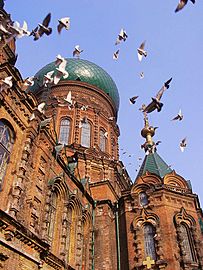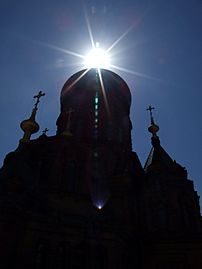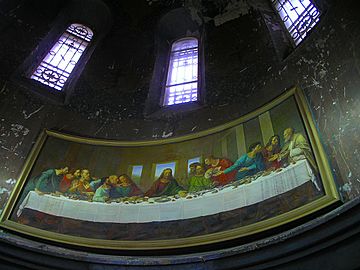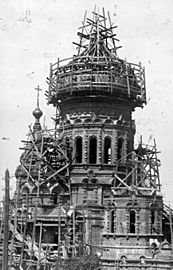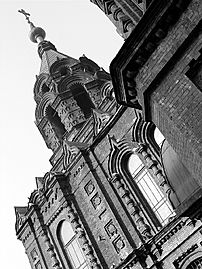Saint Sophia Cathedral, Harbin facts for kids
Quick facts for kids Saint Sophia Cathedral圣索菲亚教堂 Софийский собор |
|
|---|---|
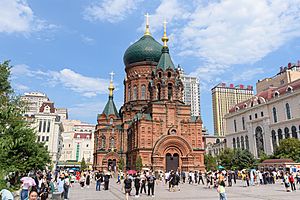
The Cathedral of the Holy Wisdom of God in Harbin, China. Built in 1907 and expanded from 1923–32, it was closed during the Great Leap Forward and Cultural Revolution periods, and turned into a museum in 1997.
|
|
| Religion | |
| Affiliation | None (formerly Russian Orthodox Church) |
| Status | Museum |
| Location | |
| Location | Harbin, China |
| Architecture | |
| Architectural type | Church |
| Architectural style | Russian Revival architecture |
| Groundbreaking | 1907 |
| Completed | 1932 |
| Height (max) | 53.35 m |
| Saint Sophia Cathedral, Harbin | |||||||
|---|---|---|---|---|---|---|---|
| Chinese name | |||||||
| Simplified Chinese | 圣索菲亚教堂 | ||||||
| Traditional Chinese | 聖索菲亞教堂 | ||||||
|
|||||||
| Russian name | |||||||
| Russian | Софийский собор в Харбине | ||||||
| Romanization | Sofiyskiy sobor v Kharbine | ||||||
The Saint Sophia Cathedral in Harbin, China, is a famous building that used to be a Russian Orthodox church. It is located in the central part of Harbin City, in the Daoli District. Today, it is no longer a church but a popular museum.
Contents
History of Saint Sophia Cathedral
The Saint Sophia Orthodox Cathedral was first built in 1907. This happened after the Trans-Siberian Railway was finished in 1903. This railway connected Vladivostok to northeast China.
Russian soldiers arrived in the area after Russia lost a war against Japan in 1904–1905. The church was built to help the army feel more confident and hopeful. It was meant to be an important spiritual symbol. The first church was made of wood and finished in March 1907.
Expanding the Cathedral
By 1921, Harbin had many people, including 100,000 Russians. The church was made much bigger and renovated starting in September 1923. A special ceremony was held to mark the beginning of this work.
The expansion took nine years to complete, finishing in November 1932. The Saint Sophia Church became a huge and beautiful building. It was known as the largest Orthodox church in the Far East.
What the Cathedral Looks Like
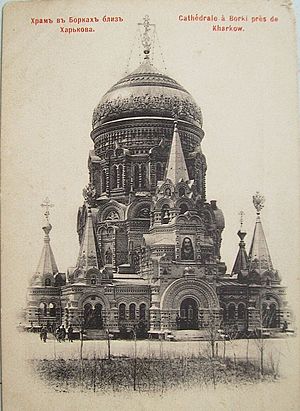
The church is found at the corner of Toulong Street and Zhaolin Street. It stands about 53.3 meters (175 feet) tall. The building covers an area of 721 square meters (about 7,760 square feet).
It is a great example of Russian Revival architecture, which means it looks like old Russian buildings. The main part of the church is shaped like a cross. A large green-tipped dome sits on top of the main hall. When the sun shines, the church and the area around it look a lot like Red Square in Moscow.
When the Cathedral Closed
After the People's Republic of China was formed in 1949, the government made changes. Treaties were signed between the Soviet and Chinese governments. These agreements meant that Russian churches would be controlled by China.
Because of this, the cathedral was closed for many years. It was closed during periods like the Great Leap Forward (1958–1961) and the Cultural Revolution (1966–1976).
Even though the cathedral was very strong, it was not used as a church anymore. It became a warehouse for a nearby department store. Its windows were blocked with bricks, and small trees even started growing from the roof. Tall concrete buildings were built very close to the church on all sides. This made it hard to see the cathedral from the street. For many years, it was hidden away in the city.
Bringing the Cathedral Back to Life
In 1996, the Chinese government decided to protect the cathedral. It was named a national cultural heritage site. A newspaper article then told people about the "hidden" cathedral. This made many local people want to help restore it.
Companies, businesses, and even workers from nearby stores gave money. About 12 million yuan (which was about $1.5 million US dollars) was collected. In 1997, the buildings around the cathedral were torn down. This made the cathedral visible again.
A new area called "Harbin Architecture Square" was created. It showed off the cathedral with a big new fountain. This European-looking space became a symbol of culture and art for the city. It was presented to the public as a proud part of Harbin's history.
The Cathedral as a Museum
Since 1997, the cathedral has been used as the Municipal Architecture and Art Museum. It is also called the Harbin Architectural Art Gallery. The museum shows the different types of architecture in Harbin over time.
At the official ceremony on September 2, 1997, the mayor of Harbin, Wang Guangdao, spoke about the restoration. He said that bringing the cathedral back to life made the people of Harbin feel inspired. He also said it helped people in China and other countries learn about Harbin. This project also helped the city's economy grow faster.
The restoration was part of Harbin's plan to turn its old buildings into tourist attractions. By restoring them, they became important landmarks. These restored buildings are seen as symbols of civilization and culture in China.
Gallery
See also
 In Spanish: Iglesia de Santa Sofía (Harbin) para niños
In Spanish: Iglesia de Santa Sofía (Harbin) para niños
- Russian Revival architecture
- Chinese Orthodox Church
- Christianity in China
- Harbin Russians
- Russians in China
- Russian Orthodox Church
Churches in Harbin
- Church of the Intercession in Harbin (Orthodox)
- Harbin Nangang Christian Church (Protestant)
- Sacred Heart Cathedral of Harbin (Roman Catholic)



